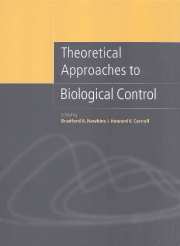Book contents
- Frontmatter
- Contents
- List of contributors
- Preface
- Part I Biological control theory: past and present
- Part II Ecological considerations
- Part III Spatial considerations
- Part IV Genetic/evolutionary considerations
- Part V Microbes and pathogens
- 17 The dynamics of insect–pathogen interactions
- 18 Host–pathogen–parasitoid systems
- 19 Persistence of natural enemies of weeds and insect pests in heterogenous environments
- 20 Application of insect–pathogen models to biological control
- 21 Dose–response relationships in biocontrol of plant disease and their use to define pathogen refuge size
- Index
21 - Dose–response relationships in biocontrol of plant disease and their use to define pathogen refuge size
from Part V - Microbes and pathogens
Published online by Cambridge University Press: 13 August 2009
- Frontmatter
- Contents
- List of contributors
- Preface
- Part I Biological control theory: past and present
- Part II Ecological considerations
- Part III Spatial considerations
- Part IV Genetic/evolutionary considerations
- Part V Microbes and pathogens
- 17 The dynamics of insect–pathogen interactions
- 18 Host–pathogen–parasitoid systems
- 19 Persistence of natural enemies of weeds and insect pests in heterogenous environments
- 20 Application of insect–pathogen models to biological control
- 21 Dose–response relationships in biocontrol of plant disease and their use to define pathogen refuge size
- Index
Summary
Introduction
Biological control of plant disease is concerned with the effect of antagonistic microbes on the ability of a pathogen to survive and to infect its host (Cook & Baker, 1983; Handelsman & Stabb, 1996). Typically, in practical applications, high doses of antagonistic microbes are introduced inundatively or augmentatively to soil, seed or foliar environments. Once established in soil or on plant surfaces, populations of the microbes then suppress pathogen populations by one of several mechanisms including production of antibiotics, competition for essential resources, parasitism of pathogen propagules, or by induction of antimicrobial resistance responses in host tissues (Handelsman & Stabb, 1996).
Like biological control of insect pests or weeds, biocontrol of plant pathogens via inundative or augmentative introductions of antagonistic microbes is not usually 100% effective. Nonetheless, microbial antagonists can provide consistent suppression of disease and, consequently, some of these microbes are beginning to be used successfully in commercial agriculture. The use of these microbial products has been initiated without a strong theoretical foundation for understanding the relative effectiveness of individual antagonist strains. Recently, I hypothesized that quantitative concepts developed to describe host–pathogen interactions provided a valuable resource that could be applicable to interactions between antagonist and pathogen populations (Johnson, 1994). Evaluation of this hypothesis led to the extension of a pathogen dose–disease response relationship to account for the effect of the initial population size (dose) of an antagonistic microbe on the incidence of disease.
- Type
- Chapter
- Information
- Theoretical Approaches to Biological Control , pp. 385 - 392Publisher: Cambridge University PressPrint publication year: 1999
- 1
- Cited by



